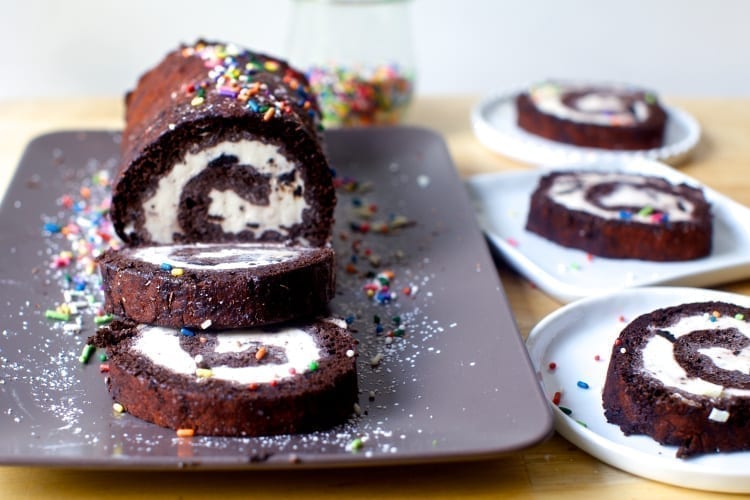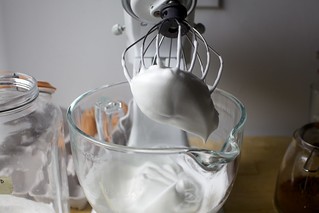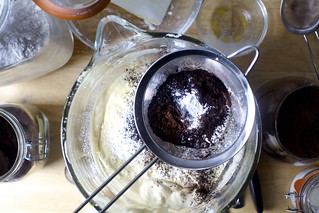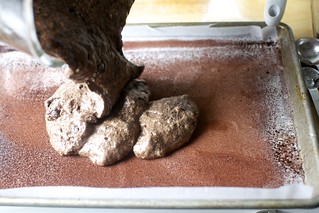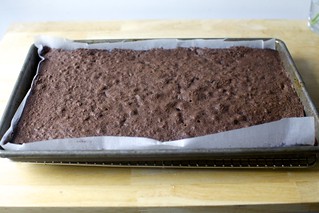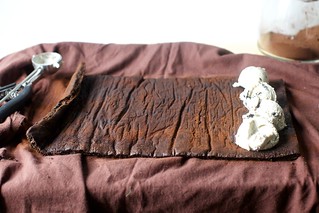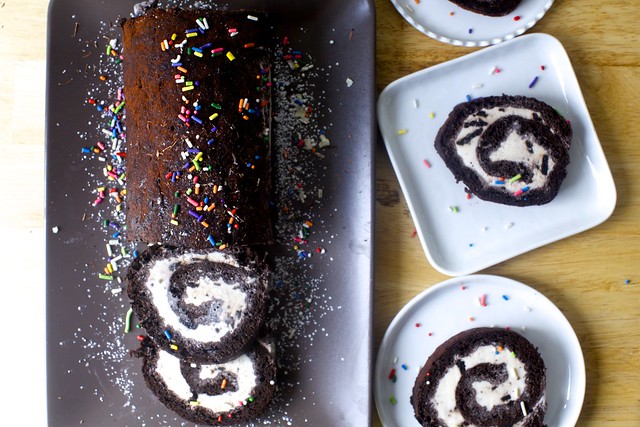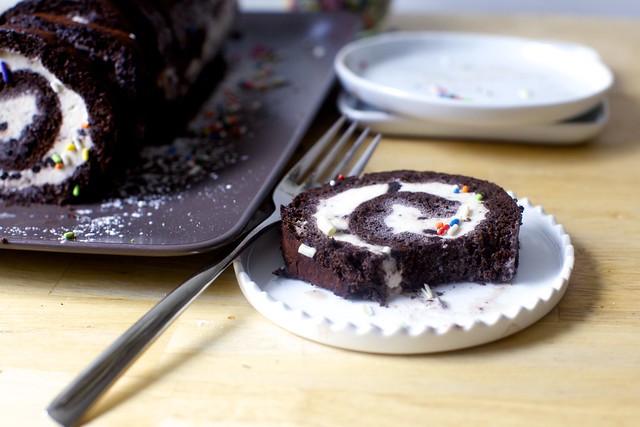Wait, come back! No matter how charming Mary Berry and Paul Hollywood made them look on that early episode of Great British Bake Off, I know how most of us feel actually feel about making rolled cakes, which is that they’re the worst: pesky with separated eggs, fragile, cracking, prone to failure, causing foul language to leave the mouth of the person cooking.
 (“You owe me a quarter, mom.” “Not if you want cake.” is a conversation that might or might not happen around here on Passover.) But this one is different. With flour and cocoa inside, plus an additional egg, it’s stretchier and softer, and it doesn’t fight you so much when you want to roll, unroll it, and then reroll it. And you want to do all of these things because this is one of the prettiest ice cream cakes I’ve ever made, and much easier and faster than it looks.
(“You owe me a quarter, mom.” “Not if you want cake.” is a conversation that might or might not happen around here on Passover.) But this one is different. With flour and cocoa inside, plus an additional egg, it’s stretchier and softer, and it doesn’t fight you so much when you want to roll, unroll it, and then reroll it. And you want to do all of these things because this is one of the prettiest ice cream cakes I’ve ever made, and much easier and faster than it looks.
This is one of those old-school recipes I’d seen bouncing around for years and studiously avoided due to an inherent and well-earned distrust of rolled cakes. But then it showed up in a new book this spring, The Vintage Baker*, there as a holiday-ready peppermint cake roll, and I couldn’t resist any longer. I love this story behind this book, which is that one day a decade ago, Jessie Sheehan, then a baker at the new Baked bakery in Red Hook, went into an antique/junk shop with her not-exactly-patient toddler in a stroller that didn’t exactly fit in the narrow aisles, something I can relate to just a little bit. She spotted boxes filled with brightly colored antique recipe pamphlets, the kind that were once distributed by brands as a thank you for purchases but really were just brilliant marketing devices, since all the recipes called for that brand’s goods, and in a haste to leave, scooped up as many as she could carry. She ended up going back for more and more, amassing quite a collection, and the resulting baking she did — with flavor and ingredient tweaks for modern tastes — is assembled in this book. Butterscotch pecan curls, pull-apart cinnamon raisin pull-apart flake bread, sand tarts, sour cream jumbles, and cornflake macaroons, I want to make everything in it. But I think I started in the right place.
I took many liberties with the recipe. As written, it has a whipped cream filling and ganache topping. But it’s almost summer and I want ice cream, don’t you? I went to the store to find mint chocolate cookie (a flavor from the heavens, obviously) but came up with only cookies-and-cream. I decided to stick fully with the cookies-and-cream theme, swapping a little black cocoa powder (the “Oreo maker”) into the cake roll to get it extra dark. And I while skipped the ganache topping because it felt luxurious enough but if it was, like, your birthday, I’d definitely serve some hot fudge sauce and whipped cream on the side.
* I am no neutral observer of this book. If you spotted a very elaborate photo in my last cookbook for all of those one-bowl build-your-own party cakes, that was Jessie Sheehan who swooped in to help me bake, frost, and assemble them, saving the day. I got to preview this book over the winter and loved it so much, I blurbed it too.
Ice Cream Cake Roll
As mentioned, the original recipe calls for a peppermint whipped cream filling. Instead, I used ice cream. Use any flavor you wish, but if you want to go full cookies-and-cream with this cake, as I did, use the ice cream for the filling and if you can find it, swap all or half (a little goes a long way) of the cocoa powder with black cocoa powder. Cream of tartar, an acidic ingredient, is often added to whipped egg whites to help increase their volume. I discovered I was out (making too much play-doh again, obviously) and used 1/8 teaspoon plain vinegar instead. It worked great.
- 4 large eggs, separated
- 3 tablespoons granulated sugar
- Heaped 1/8 teaspoon fine sea or table salt
- Heaped 1/8 teaspoon cream of tartar (see Note)
- 1/3 cup packed dark brown sugar
- 1 1/2 teaspoons pure vanilla extract
- 1 1/2 tablespoons water
- 1/4 cup dutch-process cocoa, plus more for dusting (see Note about using black cocoa)
- 1/3 cup cake flour or 5 tablespoons all-purpose flour plus 1 teaspoon cornstarch
- Heaped 1/2 teaspoon baking powder
- 2 to 2 1/4 cups slightly softened ice cream of your choice (I used cookies and cream)
- Powdered sugar, hot fudge sauce, whipped cream, sprinkles, or all of the above to garnish
Heat oven: To 400 degrees F. Grease a 10×15-inch jelly roll pan with nonstick cooking spray or softened butter. Line pan with parchment paper and grease again. Dust with cocoa powder, knocking out any excess, and set aside.Make the cake: Place the egg whites in the bowl of a stand mixer fitted with the whisk attachment. Beat on medium speed, until foamy. Slowly add the granulated sugar in a steady stream and continue beating until soft peaks form. Add the salt and cream of tartar and whip until stiff peaks form. Scoop into large bowl and set aside. (If you’re fancy and have two stand mixer bowls, you can just switch bowls.)
Place the egg yolks in now empty bowl of the stand mixer, still fitted with the whisk attachment. Whisk the yolks on high speed, slowly adding brown sugar, until thick and ribbony, at least 5 minutes. Add the vanilla and water and mix until incorporated. With a rubber spatula, gently fold the whites into the yolks in three additions.
Place a mesh sieve or sifter over the bowl and place cake flour, cocoa powder, and baking powder in it. Sift over batter, then gently fold the dry ingredients into the wet with a rubber spatula.
Gently spread the batter into the prepared pan, using an offset spatula or butter knife to smooth it. Bake for 5 to 7 minutes (yes, that’s it!), until the cake just begins to pull away from the sides of the pan and a cake tester inserted into the center comes out clean.
Unmold cake and prepare to fill: [I always have to read this part twice.] Use a paring knife to make sure the cake isn’t stuck to any side of the pan. Sift cocoa powder over top of cake. Place a large (larger than the cake) dishcloth you don’t mind getting dirty over it. Place a cutting board or baking tray or cooling rack over the cloth that’s larger than the cake pan. Grab this board, the cloth, and the cake pan tightly together and flip the cake over, onto the cloth on the board. (The board just supports the cloth; its work here is done.) Lift your cake pan and it should unmold onto cloth. Gently peel the parchment paper off the cake. Use your paring knife to cut a thin edge (about 1/4-inch) off all sides of the cake; it’s easier to roll with softer edges. Sift more cocoa powder over the back of the cake. Use the cloth it is on to roll it tightly into a spiral, within the dish towel. Rest on a cooling rack, seam side-down, until it reaches room temperature, about 30 minutes.
Assemble cake: Once cake is cool, gently unroll it. Spread inside of cake with slightly softened ice cream. I use a small scooper to drop dollops all over, and a small offset spatula or knife to smooth it. Work quickly so it doesn’t melt too much. Once ice cream is evenly spread, roll cake back up around it (minus the dish towel this time, but you can use it to help nudge cake into a coil). Wrap cake in plastic and freeze for at least 2 hours and preferably overnight, to re-firm the ice cream.
To serve: Decorate the cake as you wish. (I used a dusting of powdered sugar and colored sprinkles. Hot fudge sauce and whipped cream are never unwelcome.) Cut into thin 1-inch slices. Keep leftovers in the freezer, for as long as they last.
Font: smittenkitchen.com

 English
English Français
Français
